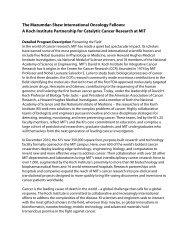Aurora's Guide to Mouse Colony Management
Aurora's Guide to Mouse Colony Management
Aurora's Guide to Mouse Colony Management
Create successful ePaper yourself
Turn your PDF publications into a flip-book with our unique Google optimized e-Paper software.
Here are the two most common situations at MIT:<br />
1- Agouti (brown, from 129 background) ES cells are injected in<strong>to</strong> black (C57B6)<br />
blas<strong>to</strong>cysts. The chimeras are a mixture of black and brown. You mate chimeras <strong>to</strong><br />
wildtype C57B6 mice. Some offspring are black. These are from the combination of a<br />
C57B6 gamete in the chimera with a C57B6 gamete in the mate. These mice are<br />
wildtype and will not have your desired alteration. Some of the offspring are brown.<br />
These are from the combination of a 129 ES cell-derived gamete in the chimera with a<br />
C57B6 gamete in the mate (the wt mate can only generate C57B6 gametes because it is<br />
not a mix). These brown offspring have 50% chance of getting the mutation you<br />
engineered in<strong>to</strong> the ES cells. All brown pups should be tested for the desired alteration.<br />
This scheme works because the agouti color is dominant over black. You colony is now<br />
starting with a mixed background of 50% 129Sv and 50% C57B6. If you desire a pure<br />
C57B6 background, you will need <strong>to</strong> backcross 19 more times <strong>to</strong> C57B6 mates. If you<br />
desire a pure 129Sv background, you can breed a wt 129Sv mouse <strong>to</strong> the chimera who<br />
has proven itself <strong>to</strong> pass on your desired genetic alteration. All of the offspring will be<br />
agouti in color, and you will simply have <strong>to</strong> genotype everything <strong>to</strong> find the few who<br />
inherited the mutation.<br />
2- Black (C57B6) ES cells are injected in<strong>to</strong> white (Balb/c) blas<strong>to</strong>cysts. This coat color<br />
combination is a bit more tricky. Balb/c skin releases an agouti pigment, which is<br />
masked and produces no color. However, when Balb/c skin cells are near C57B6 skin<br />
cells, the secreted agouti color is unmasked by the black pigment. So, a chimera that is a<br />
mix of C57B6 and Balb/c cells are often tri-colored with areas of white, areas of black,<br />
and areas of agouti in between the white and black. Do not be alarmed! These chimeras<br />
can be bred <strong>to</strong> Balb/c mates or <strong>to</strong> C57B6 mates. If bred <strong>to</strong> Balb/c, the desired offspring<br />
will be agouti in color (because each cell will contain one copy of the masked agouti<br />
color from the wt Balb/c gamete as well as the black, unmasking pigment from the<br />
altered, C57B6 gamete in the chimera). The wildtype offspring will be white. If the<br />
chimera is bred <strong>to</strong> a C57B6 mate, then the desired offspring is black (C57B6 gametes<br />
from the both the chimera and the mate) and the pups you do not want will be agouti<br />
(combination of Balb/c from the chimera and C57B6 from the mate). Breeding <strong>to</strong> a<br />
C57B6 mate means that your colony is starting off as 100%, pure background of C57B6,<br />
which can be very desirable for some experiments.<br />
Timed Pregnancies/ Plugging<br />
Timed pregnancies become necessary when you wish <strong>to</strong> look at specific embryonic<br />
stages. When mice mate, the male ejaculates a viscous substance that solidifies quickly<br />
and lasts for 12-14 hours. This vaginal plug acts as a barrier <strong>to</strong> prevent other males from<br />
mating with the female and also aid his sperm in reaching their target. The plug also<br />
provides an easy means by which <strong>to</strong> tell that a pair has mated. Based on the light/dark<br />
cycle, female mice ovulate between 11 pm and 1 am, though they can mate hours earlier<br />
or later. Therefore, plugs are checked every morning between 9 am and noon. Checking<br />
plugs <strong>to</strong>o early can disturb potential matings. If plugs are not checked by noon, they will<br />
work their way out or dissolve, though I have observed plugs as late as 2 pm. Plugs are<br />
5





